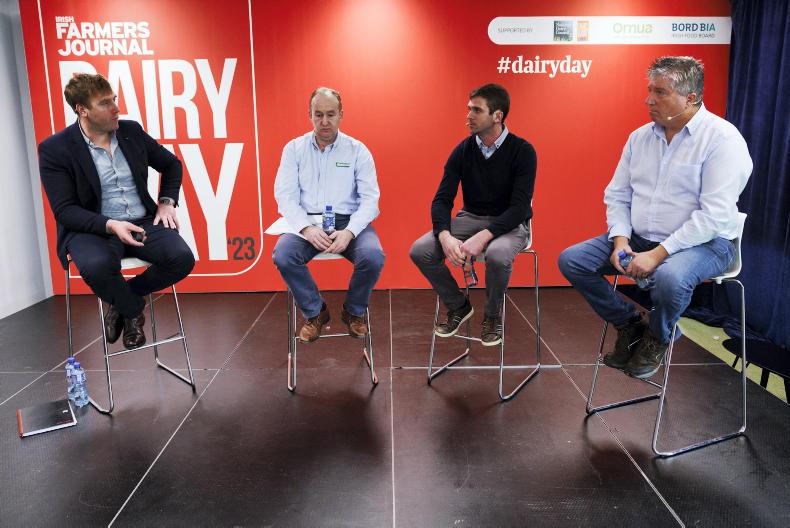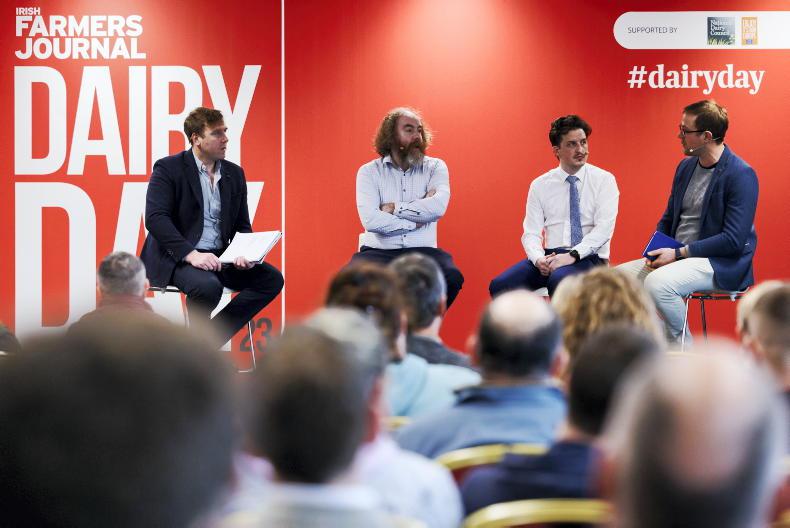Over 3,400 dairy farmers and industry personnel from across Ireland descended on Páirc Uí Chaoimh in Cork city for Dairy Day 2023 – the first time for the event to be held in Cork.
It was also the first Dairy Day since COVID-19 and the war in Ukraine; two major events that have had huge impact on dairy markets and input price inflation.
The downsides of being an open economy with greater exposure to input price inflation were laid bare at the opening session of the day – cutting costs.

Speaking at the session 'Dealing with the fallout from Nitrates' are Aidan Brennan, IFJ, Laurence Shalloo, Teagasc, along with dairy farmers Enda Duffy and Conor O'Leary. \ Donal O'Leary
Kilkenny dairy farmer Sean Cummins went through the changes to costs on his farm. Total costs per kilo of milk solids went up by 38% in 2022 and while they have dipped marginally in 2023, total costs are still 30% higher now than they were in 2021.
The reality also is that production is well back this year compared to last year.
In Sean’s case, milk solids per cow was 465kg/cow in 2022 but that’s expected to be back to 435kg/cow in 2023 when the herd is dried off in the coming weeks.

Speaking at the first session 'Cutting Costs to Protect Margin' are Aidan Brennan, Joe Patton, Teagasc, Liam Hennessy, FDC Accountants and Sean Cummins, dairy farmer, Kilkenny. \ Donal O'Leary
Sean said the bad weather in spring and autumn cost the farm production as too much middling quality silage had to be fed, when the herd would otherwise be on good-quality grass.
In terms of costs, Sean said they try to minimise waste wherever possible and that being part of a purchasing group was a help, not only in securing cheaper prices but in ensuring that he is organised because he needs to order in advance.
Despite reducing fertiliser nitrogen from 225kg N/ha in 2021 to 187kg N/ha in 2023, fertiliser remains one of the largest costs. It cost the farm €37,000 in 2021 but €65,000 last year and €69,000 this year.
On fertiliser, Teagasc’s Joe Patton said that farmers need to be careful not to make savings on fertiliser use, only for feed costs to increase as they find themselves not growing enough grass.
Teagasc profit monitor data shows that meal feeding rates increased by an average of 300kg per cow in 2022, with only 5kg of milk solids per cow extra milk produced, which represents a very poor return, Joe said.
Sean fed 800kg of meal per cow this year and 856kg of meal last year.
Cows are on minimum feed for the summer but Sean said he probably should have fed more meal in spring when cows were under pressure due to bad weather and being supplemented with poor silage.
The 250-cow farmer from Inistioge said he only tries to buy inputs that he feels deliver a return to the farm.
Genetics
There is a big focus on using genetics to improve health. He said the base of the herd is a resilient British Friesian cow and these have been crossed with Norwegian Red and Jersey. He said that if cows are naturally healthy and well looked after, they will have good immunity to disease.

Speaking at the first session 'Cutting Costs to Protect Margin' were Aidan Brennan, Joe Patton, Teagasc, Liam Hennessy, FDC Accountants and Sean Cummins, dairy farmer, Kilkenny. \ Donal O'Leary
On labour and contractor costs, Sean said these are important areas in which you can’t be too focused on reducing costs in.
“If you have the right people, treat them as well as you can, give them respect. They’re important to the farm if you want to have an efficient farm system.
“We expect to have a life outside farming and that’s fierce important after a hard year. Maintaining good working relationships with people who work on your farm is essential to the long-term success of the business.”
Nitrates
Unsurprisingly, there was big interest in nitrates at Dairy Day. Speaking at the nitrates session, dairy farmers Enda Duffy from Ballybay in Co Monaghan and Conor O’Leary from Co Cork went through the impact the cut to the derogation will have on their farms.
Enda returned home to farm full-time in 2018 and is midway through expansion plans currently milking 149 cows with plans to go 160 cows next year. He explained that there are over 170 pregnant animals on the farm currently.
Heifers are already contract-reared so that’s not an option. As Enda’s herd is in the high band at 7,500kg of milk produced per year, the impact of 220kg N/ha is high.
The herd will either be capped at 130 cows and if he increased to the planned 160 cows, then an extra 16ha of land would have to be leased or a staggering 324,000 gallons of slurry exported off farm. This level of slurry exports would equate to 126% of all slurry produced on the farm based on current figures so is unrealistic.
In Conor O’Leary’s case, the farm is losing land this year anyway so the impact is magnified.
As a result of losing land Conor is phasing out a heifer sales enterprise.
Organic nitrogen is currently at 237kg N/ha and with less land and fewer heifers next year, it would be at 250kg N/ha in 2024.
As a result of the change to the new limit of 220kg N/ha, Conor will either have to source an additional 9ha of land, reduce by 21 cows or export 179,000 gallons of slurry, which is 122% of all the slurry produced on the farm based on current figures.
Teagasc’s Laurence Shalloo said that farmers need to identify the least costly option for their farm.
He said that for those in the top band, reducing milk yield to get into the middle band will be the best option.
For others, contract rearing and leasing additional land, followed by exporting slurry, and, lastly, reducing cow numbers are the least cost options.
Exporting slurry
He said that exporting slurry will come at a cost, with the cost of actually moving the slurry the smallest part of the cost as the lost nutrients, particularly P and K will have to be replaced.
He said that the Department asked Teagasc to review nitrogen excretion rates for youngstock and he said they have now been revised to give a different excretion rate per month of life. He said that the amount of nitrogen deemed to be produced over the winter period is set to increase also, which will help farmers relying on exporting slurry.
The inaugural Dairy Dragons event took place at Dairy Day and was won by Lely Centre, Mitchelstown, with Con O’Mahony taking home the trophy. The session recognised and rewarded innovation in agriculture with four companies participating for the award. These were Dairymaster, MSD Animal Health, Terra Nutritech and Lely. Each company representative had five minutes to pitch their product to five judges and the judges had a virtual €50,000 to award based on sustainability of the product, return on investment and labour saving. 
David Leydon, ifac; judges Shane Fitzgerald and Bryan Hynes, overall winner Con O’Mahony, Lely Centre Mitchelstown, judges Anne Marie Butterfield, Tony O’Regan and Shane O’Loughlin with CEO of The Agricultural Trust William Minchin.
Cutting costs, nitrates and milk price for 2024 were talks which commanded the largest audiences.Reducing waste, only ordering what is needed and assessing if there is a return from the product are the guiding principles used by Sean Cummins when it comes to controlling costs. Laurence Shalloo said that for those in the top band, reducing milk yield to get into the middle band will be the best option. For others, contract rearing and leasing additional land followed by exporting slurry and, lastly, reducing cow numbers are the best options.
Over 3,400 dairy farmers and industry personnel from across Ireland descended on Páirc Uí Chaoimh in Cork city for Dairy Day 2023 – the first time for the event to be held in Cork.
It was also the first Dairy Day since COVID-19 and the war in Ukraine; two major events that have had huge impact on dairy markets and input price inflation.
The downsides of being an open economy with greater exposure to input price inflation were laid bare at the opening session of the day – cutting costs.

Speaking at the session 'Dealing with the fallout from Nitrates' are Aidan Brennan, IFJ, Laurence Shalloo, Teagasc, along with dairy farmers Enda Duffy and Conor O'Leary. \ Donal O'Leary
Kilkenny dairy farmer Sean Cummins went through the changes to costs on his farm. Total costs per kilo of milk solids went up by 38% in 2022 and while they have dipped marginally in 2023, total costs are still 30% higher now than they were in 2021.
The reality also is that production is well back this year compared to last year.
In Sean’s case, milk solids per cow was 465kg/cow in 2022 but that’s expected to be back to 435kg/cow in 2023 when the herd is dried off in the coming weeks.

Speaking at the first session 'Cutting Costs to Protect Margin' are Aidan Brennan, Joe Patton, Teagasc, Liam Hennessy, FDC Accountants and Sean Cummins, dairy farmer, Kilkenny. \ Donal O'Leary
Sean said the bad weather in spring and autumn cost the farm production as too much middling quality silage had to be fed, when the herd would otherwise be on good-quality grass.
In terms of costs, Sean said they try to minimise waste wherever possible and that being part of a purchasing group was a help, not only in securing cheaper prices but in ensuring that he is organised because he needs to order in advance.
Despite reducing fertiliser nitrogen from 225kg N/ha in 2021 to 187kg N/ha in 2023, fertiliser remains one of the largest costs. It cost the farm €37,000 in 2021 but €65,000 last year and €69,000 this year.
On fertiliser, Teagasc’s Joe Patton said that farmers need to be careful not to make savings on fertiliser use, only for feed costs to increase as they find themselves not growing enough grass.
Teagasc profit monitor data shows that meal feeding rates increased by an average of 300kg per cow in 2022, with only 5kg of milk solids per cow extra milk produced, which represents a very poor return, Joe said.
Sean fed 800kg of meal per cow this year and 856kg of meal last year.
Cows are on minimum feed for the summer but Sean said he probably should have fed more meal in spring when cows were under pressure due to bad weather and being supplemented with poor silage.
The 250-cow farmer from Inistioge said he only tries to buy inputs that he feels deliver a return to the farm.
Genetics
There is a big focus on using genetics to improve health. He said the base of the herd is a resilient British Friesian cow and these have been crossed with Norwegian Red and Jersey. He said that if cows are naturally healthy and well looked after, they will have good immunity to disease.

Speaking at the first session 'Cutting Costs to Protect Margin' were Aidan Brennan, Joe Patton, Teagasc, Liam Hennessy, FDC Accountants and Sean Cummins, dairy farmer, Kilkenny. \ Donal O'Leary
On labour and contractor costs, Sean said these are important areas in which you can’t be too focused on reducing costs in.
“If you have the right people, treat them as well as you can, give them respect. They’re important to the farm if you want to have an efficient farm system.
“We expect to have a life outside farming and that’s fierce important after a hard year. Maintaining good working relationships with people who work on your farm is essential to the long-term success of the business.”
Nitrates
Unsurprisingly, there was big interest in nitrates at Dairy Day. Speaking at the nitrates session, dairy farmers Enda Duffy from Ballybay in Co Monaghan and Conor O’Leary from Co Cork went through the impact the cut to the derogation will have on their farms.
Enda returned home to farm full-time in 2018 and is midway through expansion plans currently milking 149 cows with plans to go 160 cows next year. He explained that there are over 170 pregnant animals on the farm currently.
Heifers are already contract-reared so that’s not an option. As Enda’s herd is in the high band at 7,500kg of milk produced per year, the impact of 220kg N/ha is high.
The herd will either be capped at 130 cows and if he increased to the planned 160 cows, then an extra 16ha of land would have to be leased or a staggering 324,000 gallons of slurry exported off farm. This level of slurry exports would equate to 126% of all slurry produced on the farm based on current figures so is unrealistic.
In Conor O’Leary’s case, the farm is losing land this year anyway so the impact is magnified.
As a result of losing land Conor is phasing out a heifer sales enterprise.
Organic nitrogen is currently at 237kg N/ha and with less land and fewer heifers next year, it would be at 250kg N/ha in 2024.
As a result of the change to the new limit of 220kg N/ha, Conor will either have to source an additional 9ha of land, reduce by 21 cows or export 179,000 gallons of slurry, which is 122% of all the slurry produced on the farm based on current figures.
Teagasc’s Laurence Shalloo said that farmers need to identify the least costly option for their farm.
He said that for those in the top band, reducing milk yield to get into the middle band will be the best option.
For others, contract rearing and leasing additional land, followed by exporting slurry, and, lastly, reducing cow numbers are the least cost options.
Exporting slurry
He said that exporting slurry will come at a cost, with the cost of actually moving the slurry the smallest part of the cost as the lost nutrients, particularly P and K will have to be replaced.
He said that the Department asked Teagasc to review nitrogen excretion rates for youngstock and he said they have now been revised to give a different excretion rate per month of life. He said that the amount of nitrogen deemed to be produced over the winter period is set to increase also, which will help farmers relying on exporting slurry.
The inaugural Dairy Dragons event took place at Dairy Day and was won by Lely Centre, Mitchelstown, with Con O’Mahony taking home the trophy. The session recognised and rewarded innovation in agriculture with four companies participating for the award. These were Dairymaster, MSD Animal Health, Terra Nutritech and Lely. Each company representative had five minutes to pitch their product to five judges and the judges had a virtual €50,000 to award based on sustainability of the product, return on investment and labour saving. 
David Leydon, ifac; judges Shane Fitzgerald and Bryan Hynes, overall winner Con O’Mahony, Lely Centre Mitchelstown, judges Anne Marie Butterfield, Tony O’Regan and Shane O’Loughlin with CEO of The Agricultural Trust William Minchin.
Cutting costs, nitrates and milk price for 2024 were talks which commanded the largest audiences.Reducing waste, only ordering what is needed and assessing if there is a return from the product are the guiding principles used by Sean Cummins when it comes to controlling costs. Laurence Shalloo said that for those in the top band, reducing milk yield to get into the middle band will be the best option. For others, contract rearing and leasing additional land followed by exporting slurry and, lastly, reducing cow numbers are the best options. 









 This is a subscriber-only article
This is a subscriber-only article











SHARING OPTIONS: